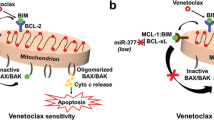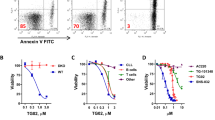Abstract
B-cell chronic lymphocytic leukemia (CLL), the most common leukemia in older adults, remains largely incurable and novel treatments are urgently required. We previously reported powerful pro-apoptotic actions of bezafibrate (BEZ) and medroxyprogesterone acetate (MPA) against Burkitts lymphoma cells. Here, we demonstrate that BEZ and MPA individually, and more potently when combined (BEZ+MPA), induce apoptosis of unsorted and CD19+ve-selected CLL cells and abrogate the pro-proliferative activity of CD40L. This action was tumor cell specific, as the drugs had little impact on normal donor cells. The antiproliferative actions of BEZ+MPA were associated with the generation of reactive oxygen species (ROS), and the proapoptotic actions were associated with the generation of both ROS and mitochondrial superoxide (MSO). BEZ increased prostaglandin D2 (PGD2) synthesis by CLL cells, and treatment with PGD2 and its antineoplastic derivative 15dΔ12,14,PGJ2 recapitulated BEZ-induced antiproliferative and proapoptotic actions. The PGD2 receptor antagonist, BW868C, did not block BEZ or PGD2 activity against CLL cells. The potency of BEZ+MPA against CLL cells mirrored that of chlorambucil, and BEZ+MPA combined with chlorambucil was more potent than either treatment alone. Given the known safety profiles of BEZ and MPA, our data warrant further investigation of their potential as novel therapy for CLL.
This is a preview of subscription content, access via your institution
Access options
Subscribe to this journal
Receive 12 print issues and online access
$259.00 per year
only $21.58 per issue
Buy this article
- Purchase on Springer Link
- Instant access to full article PDF
Prices may be subject to local taxes which are calculated during checkout







Similar content being viewed by others
References
Ghia P, Ferreri AM, Galigaris-Cappio F . Chronic lymphocytic leukemia. Crit Rev Oncol Hematol 2007; 64: 234–246.
Oscier D, Fegan C, Hillmen P, Illidge T, Johnson S, Maguire P et al. Guidelines on the diagnosis and management of chronic lymphocytic leukaemia. Br J Haematol 2004; 125: 294–317.
Kay NE, Rai KR, O'Brien S . Chronic lymphocytic leukemia: current and emerging treatment approaches. Clin Adv Hematol Oncol 2006; 4 (11 Suppl 22): 1–12.
Wierda W, O'Brien S, Faderl S, Ferrajoli A, Wang X, Do KA et al. A retrospective comparison of three sequential groups of patients with recurrent/refractory chronic lymphocytic leukemia treated with fludarabine-based regimens. Cancer 2006; 106: 337–345.
Keating MJ, O'Brien S, Albitar M, Lerner S, Plunkett W, Giles F et al. Early results of a chemoimmunotherapy regimen of fludarabine, cyclophosphamide, and rituximab as initial therapy for chronic lymphocytic leukemia. J Clin Oncol 2005; 23: 4079–4088.
Wierda W, O'Brien S, Wen S, Faderl S, Garcia-Manero G, Thomas D et al. Chemoimmunotherapy with fludarabine, cyclophosphamide, and rituximab for relapsed and refractory chronic lymphocytic leukemia. J Clin Oncol 2005; 23: 4070–4078.
Steurer M, Pall G, Richards S, Schwarzer G, Bohlius J, Greil R . Purine antagonists for chronic lymphocytic leukaemia. Cochrane Database Syst Rev (Online) 2006; 3: CD004270.
Nabhan C, Coutre S, Hillmen P . Minimal residual disease in chronic lymphocytic leukaemia: is it ready for primetime? Br J Haematol 2007; 136: 379–392.
Fenton SL, Luong QT, Sarafeim A, Mustard KJ, Pound J, Desmond JC et al. Fibrates and medroxyprogesterone acetate induce apoptosis of primary Burkitt's lymphoma cells and cell lines: potential for applying old drugs to a new disease. Leukemia 2003; 17: 568–575.
Bunce CM, Mountford JC, French PJ, Mole DJ, Durham J, Michell RH et al. Potentiation of myeloid differentiation by anti-inflammatory agents, by steroids and by retinoic acid involves a single intracellular target, probably an enzyme of the aldoketoreductase family. Biochimica Et Biophysica Acta 1996; 1311: 189–198.
Desmond JC, Mountford JC, Drayson MT, Walker EA, Hewison M, Ride JP et al. The aldo-keto reductase AKR1C3 is a novel suppressor of cell differentiation that provides a plausible target for the non-cyclooxygenase-dependent antineoplastic actions of nonsteroidal anti-inflammatory drugs. Cancer Res 2003; 63: 505–512.
Fenton SL, Drayson MT, Hewison M, Vickers E, Brown G, Bunce CM . Clofibric acid: a potential therapeutic agent in AML and MDS. Br J Haematol 1999; 105: 448–451.
Gagro A, McCloskey N, Challa A, Holder M, Grafton G, Pound JD et al. CD5-positive and CD5-negative human B cells converge to an indistinguishable population on signalling through B-cell receptors and CD40. Immunology 2000; 101: 201–209.
Scatena R, Bottoni P, Martorana GE, Ferrari F, De Sole P, Rossi C et al. Mitochondrial respiratory chain dysfunction, a non-receptor-mediated effect of synthetic PPAR-ligands: biochemical and pharmacological implications. Biochem Biophys Res Commun 2004; 319: 967–973.
Scatena R, Bottoni P, Vincenzoni F, Messana I, Martorana GE, Nocca G et al. Bezafibrate induces a mitochondrial derangement in human cell lines: a PPAR-independent mechanism for a peroxisome proliferator. Chem Res Toxicol 2003; 16: 1440–1447.
Gao L, Zackert WE, Hasford JJ, Danekis ME, Milne GL, Remmert C et al. Formation of prostaglandins E2 and D2 via the isoprostane pathway: a mechanism for the generation of bioactive prostaglandins independent of cyclooxygenase. J Biol Chem 2003; 278: 28479–28489.
Ray DM, Akbiyik F, Phipps RP . The peroxisome proliferator-activated receptor gamma (PPARgamma) ligands 15-deoxy-Delta12,14-prostaglandin J2 and ciglitazone induce human B lymphocyte and B cell lymphoma apoptosis by PPARgamma-independent mechanisms. J Immunol 2006; 177: 5068–5076.
Chong CR, Sullivan Jr DJ . New uses for old drugs. Nature 2007; 448: 645–646.
Fenaux P, Wang ZZ, Degos L . Treatment of acute promyelocytic leukemia by retinoids. Curr Top Microbiol Immunol 2007; 313: 101–128.
Chen Z, Zhao WL, Shen ZX, Li JM, Chen SJ, Zhu J et al. Arsenic trioxide and acute promyelocytic leukemia: clinical and biological. Curr Top Microbiol Immunol 2007; 313: 129–144.
Prince HM, Schenkel B, Mileshkin L . An analysis of clinical trials assessing the efficacy and safety of single-agent thalidomide in patients with relapsed or refractory multiple myeloma. Leuk Lymphoma 2007; 48: 46–55.
Mone AP, Cheney C, Banks AL, Tridandapani S, Mehter N, Guster S et al. Alemtuzumab induces caspase-independent cell death in human chronic lymphocytic leukemia cells through a lipid raft-dependent mechanism. Leukemia 2006; 20: 272–279.
Eucker J, Bangeroth K, Zavrski I, Krebbel H, Zang C, Heider U et al. Ligands of peroxisome proliferator-activated receptor gamma induce apoptosis in multiple myeloma. Anti-Cancer Drugs 2004; 15: 955–960.
Eucker J, Sterz J, Krebbel H, Zavrski I, Kaiser M, Zang C et al. Peroxisome proliferator-activated receptor-gamma ligands inhibit proliferation and induce apoptosis in mantle cell lymphoma. Anti-Cancer Drugs 2006; 17: 763–769.
Higashiyama K, Niiya K, Ozawa T, Hayakawa Y, Fujimaki M, Sakuragawa N . Induction of c-fos protooncogene transcription and apoptosis by delta 12-prostaglandin J2 in human Pl-21 myeloid leukemia and RC-K8 pre-B lymphoma cells. Prostaglandins 1996; 52: 143–156.
Padilla J, Kaur K, Harris SG, Phipps RP . PPAR-gamma-mediated regulation of normal and malignant B lineage cells. Ann NY Acad Sci 2000; 905: 97–109.
Ray DM, Bernstein SH, Phipps RP . Human multiple myeloma cells express peroxisome proliferator-activated receptor gamma and undergo apoptosis upon exposure to PPARgamma ligands. Clin Immunol (Orlando, FL) 2004; 113: 203–213.
Date M, Fukuchi K, Morita S, Takahashi H, Ohura K . 15-Deoxy-delta12,14-prostaglandin J2, a ligand for peroxisome proliferators-activated receptor-gamma, induces apoptosis in human hepatoma cells. Liver Int 2003; 23: 460–466.
Hayashi N, Nakamori S, Hiraoka N, Tsujie M, Xundi X, Takano T et al. Antitumor effects of peroxisome proliferator activate receptor gamma ligands on anaplastic thyroid carcinoma. Inter J Oncol 2004; 24: 89–95.
Kondo M, Shibata T, Kumagai T, Osawa T, Shibata N, Kobayashi M et al. 15-Deoxy-Delta(12,14)-prostaglandin J(2): the endogenous electrophile that induces neuronal apoptosis. Proc Nat Acad Sci USA 2002; 99: 7367–7372.
Lin MS, Chen WC, Bai X, Wang YD . Activation of peroxisome proliferator-activated receptor gamma inhibits cell growth via apoptosis and arrest of the cell cycle in human colorectal cancer. J Dig Dis 2007; 8: 82–88.
Liu H, Zang C, Fenner MH, Possinger K, Elstner E . PPARgamma ligands and ATRA inhibit the invasion of human breast cancer cells in vitro. Breast Cancer Res Treat 2003; 79: 63–74.
Morosetti R, Servidei T, Mirabella M, Rutella S, Mangiola A, Maira G et al. The PPARgamma ligands PGJ2 and rosiglitazone show a differential ability to inhibit proliferation and to induce apoptosis and differentiation of human glioblastoma cell lines. Inter J Oncol 2004; 25: 493–502.
Nikitakis NG, Siavash H, Hebert C, Reynolds MA, Hamburger AW, Sauk JJ . 15-PGJ2, but not thiazolidinediones, inhibits cell growth, induces apoptosis, and causes downregulation of Stat3 in human oral SCCa cells. Br J Cancer 2002; 87: 1396–1403.
Hasegawa H, Yamada Y, Komiyama K, Hayashi M, Ishibashi M, Sunazuka T et al. A novel natural compound, a cycloanthranilylproline-derivative (fuligocandin B), sensitizes leukemia cells to TRAIL-induced apoptosis through 15d-PGJ2 production. Blood 2007; 110: 1664–1674.
Yoshikuni Y, Chokai S, Ozaki T, Yoshida H, Nakane M, Kuwabara K . Hypolipidemic effect of NS-1 and other related drugs in rhesus monkeys. Atherosclerosis 1988; 74: 149–156.
Heintel D, Kienle D, Shehata M, Krober A, Kroemer E, Schwarzinger I et al. High expression of lipoprotein lipase in poor risk B-cell chronic lymphocytic leukemia. Leukemia 2005; 19: 1216–1223.
Pallasch CP, Schwamb J, Konigs S, Schulz A, Debey S, Kofler D et al. Targeting lipid metabolism by the lipoprotein lipase inhibitor orlistat results in apoptosis of B-cell chronic lymphocytic leukemia cells. Leukemia 2008; 22: 585–592.
Totsuka M, Miyashita Y, Ito Y, Watanabe H, Murano T, Shirai K . Enhancement of preheparin serum lipoprotein lipase mass by bezafibrate administration. Atherosclerosis 2000; 153: 175–179.
Bentel JM, Birrell SN, Pickering MA, Holds DJ, Horsfall DJ, Tilley WD . Androgen receptor agonist activity of the synthetic progestin, medroxyprogesterone acetate, in human breast cancer cells. Mol Cell Endocrinol 1999; 154: 11–20.
Kawaguchi M, Watanabe J, Hamano M, Kamata Y, Arai T, Nishimura Y et al. Medroxyprogesterone acetate stimulates cdk inhibitors, p21 and p27, in endometrial carcinoma cells transfected with progesterone receptor-B cDNA. Eur J Gynaecol Oncol 2006; 27: 33–38.
Poulin R, Baker D, Poirier D, Labrie F . Androgen and glucocorticoid receptor-mediated inhibition of cell proliferation by medroxyprogesterone acetate in ZR-75-1 human breast cancer cells. Breast Cancer Res Treat 1989; 13: 161–172.
Florio S, Crispino L, Ciarcia R, Vacca G, Pagnini U, de Matteis A et al. MPA increases idarubicin-induced apoptosis in chronic lymphatic leukaemia cells via caspase-3. J Cell Biochem 2003; 89: 747–754.
Pagnini U, Pacilio C, Florio S, Crispino A, Claudio PP, Giordano A et al. Medroxyprogesterone acetate increases anthracyclines uptake in chronic lymphatic leukemia cells: role of nitric oxide and lipid peroxidation. Anticancer Res 2000; 20 (1A): 33–42.
Zibera C, Gibelli N, Maestri L, Della Cuna GR . Medroxyprogesterone-acetate reverses the MDR phenotype of the CG5-doxorubicin resistant human breast cancer cell line. Anticancer Res 1995; 15: 745–749.
Acknowledgements
This study was supported by grants from the Leukaemia Research Fund UK. CP is the recipient of a BBSRC PhD studentship. We thank Professor Paul Moss for provision of early CLL samples. REH intellectual input, principal laboratory experimentation and manuscript preparation; GP supply and analysis of CLL samples; NJD laboratory experimentation and manuscript preparation; FLK laboratory experimentation and manuscript preparation; JB laboratory experimentation; JD statistical analyses; CP laboratory experimentation; TS laboratory experimentation; MD and CB co-PIs and manuscript preparation. None of the authors have a conflict of interest.
Author information
Authors and Affiliations
Corresponding author
Rights and permissions
About this article
Cite this article
Hayden, R., Pratt, G., Davies, N. et al. Treatment of primary CLL cells with bezafibrate and medroxyprogesterone acetate induces apoptosis and represses the pro-proliferative signal of CD40-ligand, in part through increased 15dΔ12,14,PGJ2. Leukemia 23, 292–304 (2009). https://doi.org/10.1038/leu.2008.283
Received:
Revised:
Accepted:
Published:
Issue Date:
DOI: https://doi.org/10.1038/leu.2008.283
Keywords
This article is cited by
-
PGD2 displays distinct effects in diffuse large B-cell lymphoma depending on different concentrations
Cell Death Discovery (2023)
-
Valproic acid disables the Nrf2 anti-oxidant response in acute myeloid leukaemia cells enhancing reactive oxygen species-mediated killing
British Journal of Cancer (2022)
-
Isocitrate dehydrogenase 2 inhibitor enasidenib synergizes daunorubicin cytotoxicity by targeting aldo-keto reductase 1C3 and ATP-binding cassette transporters
Archives of Toxicology (2022)
-
Selective inhibition of aldo-keto reductase 1C3: a novel mechanism involved in midostaurin and daunorubicin synergism
Archives of Toxicology (2021)
-
Aldo-keto reductase 1C3 (AKR1C3): a missing piece of the puzzle in the dinaciclib interaction profile
Archives of Toxicology (2018)



